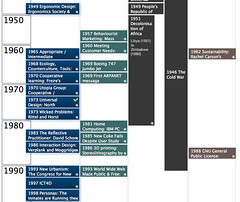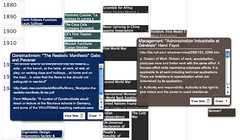Who should decide what products, services, and structures shape our lives? In political debates, our answers play out between markets on one hand and the state on the other. On issues including power generation, healthcare, or transportation, we tend to argue about accountable corporations versus the accountable state. But accountability is only a retrospective tool of democracy. It says nothing about a question of fundamental importance to any group: who should design the things which shape our lives? Is it even possible for values of democratic participation to apply to the way we design our streets, devices, and media? Or is it best to provide feedback through our votes, purchases, and tech support phone calls?
This term, I have been reviewing the relationship between democracy and design. This puts me at odds with public impressions about the MIT Media Lab, where I am a gradstudent. In our magical lab full of robots, Lego, and powerful computers, we’re supposed to imagine and invent the future. And we do. Some of my colleagues combine personal virtuosic artistry and engineering capabilities to create new inventions or platforms. Others develop transformative technologies through attentive ethnography, collaboration and community outreach. And yet, democratic values of design seem contrary to our hard-earned positions as elite makers.
To explore this question from several angles, I have been studying co-design in a broader historical context. Co-design is a class of design approaches which involve communities of practice as active designers in the design process. In a case close to home, Sasha Costanza-Chock was part of the VozMob project, a collaborative partnership between the Annenberg School for Communication at USC and the Institute of Popular Eduation of Southern California. VozMob is “a platform for immigrant and/or low-wage workers in Los Angeles to create stories about their lives and communities directly from cell phones.” It was developed over two years through a cooperative design process involving articulated principles of social justice, a shared governance structure, and day-to-day collaboration on decisions about research and design. VozMob won the 2010 World Summit Award for best Mobile Content in the M-Inclusion and Empowerment category.
Articles about co-design often contrast their methods with the rest of design, which is presented as a practice which concentrates design power in the hands of those with capital and expertise. Although those claims have an intuitive appeal, I wanted to trace that history more precisely while also becoming more generally familiar with theories and approaches within design. To anchor my reading, I developed a timeline of co-design in historical context. Here are some highlights from my study:

Draft version of my timeline of co-design in historical context
Threads from the Historical Timeline of Co-Design
The story of modern design begins with mass production and the shift away from handmade goods to factories. (In the United States, the Mercer Museum offers a wonderful presentation of pre-industrial trades). During the period of industrialisation, design and production were literally taken out of people’s homes, out of their hands, and optimised for mass production. The great infrastructure projects of the industrial era supported that production by building enhanced distribution networks to feed the market. Along with the great benefits this brought, it created a situation in which no one understands how things are made and in consequence, few people expect to have a say in how things are designed. In the 19th century, Marx included this separation between consumer-workers and ownership-design in his writings on alienation in capitalist society (alienation is explained in a great summary podcast with Jonathan Wolff on Philosophybites).
Another thread I traced in my timeline was the history of management thinking. In the early 20th century, Frederick Taylor timed employees and evaluated their physical motions to develop a theory of Scientific Management which aimed to optimise the output of a team or factory. Shortly thereafter, Henri Fayol founded the first school of management and published “Administration Industrielle et Générale,” proposing a model of management for hierarchical pay-incentivised organisations such as factories.
While co-design is an alternative to hierarchical notions of organising, it’s also possible to draw a line from Taylor’s scientific management to the ideas and methods of ergonomics and accessibility. Taylorist approaches to kitchen design, optimised for small spaces and minimal steps, had first been developed in Frankfurt in the 1920s. Ergonomics developed as a trans-Atlantic design movement after the second world war. During the war, designers had been trying to develop military systems which took into account human factors as well as the technical ones. After the war they started to apply ergonomic approaches more broadly to factories and offices. In the 1970s, Ronald Mace expanded this vision into Universal Design and accessibility. By studying the capabilities of people with disabilities, Mace developed design standards which could open access to people excluded by then-current design affordances. Mace was influential in developing the American 1988 Fair Housing Amendments Act and the 1990 Americans with Disabilities Act, laws prohibiting discrimination in design based on disability.
During the mid-20th century, companies were also beginning to realise that they simply couldn’t assume they knew more than consumers. In an interview poublished in Winograd’s “Bringing Design to Software,” Donald Schön tells the story of Scotch tape. 3M thought they had invented a great technology for bookbinding, but consumers put Scotch tape to a larger variety of uses, leading 3M to rethink and redesign their product. At a strategic level, companies were discovering that their fundamental notions differed significantly from what customers expected. In the 1960 Harvard Business Review article “Marketing Myopia“, Theodore Levitt famously argued that companies should ask themselves “what business are you really in?” Companies which focused on their product rather than their customers were not likely to succeed. Focus groups, articulated by Robert Merton in “The Focused Interview”(pdf) were growing in importance at the same time. Interviews and studies of consumer response to product prototypes became an important part of product development.
Outside the sphere of Western business theory, resistance against European empires was inspiring alternative models of production. In Bengal in in the first decade of the 20th century, the Swadeshi movement rejected British imports in favour of domestically-produced goods. In Mohandas Gandhi’s 1909 book “Indian Home Rule,” he argued for local production of cloth. Gandhi also called for an end to the expansion of railroads, the veins of British military and economic power. Constructive Swadeshi estasblished alternative means of production, while others boycotted or even destroyed British goods. The Indian independence movement is hardly the only example of resistance through local production, but local production was so centrally important to independence that the spinning wheel remains on the Indian flag to this day.
In the 1960s, as former colonies gained independence and direct Western political control was replaced with Western aid, the UK public intellectual E.F. Schumacher argued for locally-appropriate technologies and means of production in poor countries. The Appropriate Technology movement involved engineers from wealthy countries trying to develop cheap technologies for the poor. They hoped that appropriate technologies would be more easily adopted and maintained by the poor than technologies requiring large amounts of training or complex logistics networks. During the 1960s in the United States, Rachel Carson’s book “Silent Spring” was motivating Americans to value environmental sustainability, and the Whole Earth Catalogue began connecting individuals with tools for sustainability and empowerment.
While co-design can be placed in relation to these debates about community control of sustainable production, it also involves a principled approach to human organisation in the design process. Four precursors to co-design as practiced in the VozMob project are action research, community organising, informal learning, and cooperative design. In 1946, Kurt Lewin published “Action Research and Minority Problems” (pdf), arguing that good research can involve social action by researchers. The “Action Research” proposed by Lewin involves an iterative process of intervention and fact-finding. Community organising is an area I’m just now starting to learn. The American Saul Alinksy’s 1946 Reveille for Radicals and 1971 Rules for Radicals are common reference points. Cooperative learning was championed by the Latin American figures Paulo Freire and Ivan Illich, who promoted structures of learning based on dialogue and horizontal exchange — alternatives to the hierarchical structures of industrialised society and the welfare state.
Cooperative design methods originated in Scandinavia in the 1970s and 80s when trade unions reacted against being omitted from design process of technologies at work. In Sweden, Project Utopia (pdf) included graphics design workers in the process of designing their transition to computerised technologies. To do this, they developed a laboratory to simulate possible designs where workers could envision and articulate their requirements. Many of their design techniques would be recognisable today: illustrated screen mock-ups, low-tech cardboard and wooden prototypes, and workflow cards. Utopia emphasised equality and mutual learning among communities of practice (the graphics workers), designers, and researchers.
The Utopia project fits into the final historical thread I studied this term: design thinking and practice, which is characterised by reflection and innovation on the design process itself. In 1973, Rittel and Horst published “Dilemmas in a General Theory of Planning,” arguing that “it makes no sense to talk about ‘optimal solutions’ to social problems” and that definitive, expert designs often cannot exist. In 1980s, Donald Schön led a shift from outcomes to process. In “The Reflective Practitioner,” Schön encouraged frequent “reflection in action” within the design process, as well as retrospective reflection on the process overall (summarised in this interview with John Bennett). Verplank and Moggridge’s Interaction Design (pdf) simplified design decisions to offer clients greater control over designs (youtube). In the late 1980s and 90s, design methods and theories multiplied, as the booming computer industry led designers to develop techniques for creating human computer interactions(HCI). At the heart of this ongoing discourse are the challenges of designers understanding users and the challenge of involving communities of practice in the design process. For more information on this vast area, the online Encyclopedia of Human-Computer Interaction is a tremendously informative resources.
The Timeline
These are just some of the themes present in the web-based collaborative timeline of co-design which I developed for our Intro to Civic Media course. The timeline includes details from the last two hundred years of design thinking, the history of manufacturing, geopolitical events, and a broader context of influential ideas. Using a web-based interface, users can explore these themes in greater detail as well as add research of their own. Here are two screenshots:
In hindsight, I do not consider this project to have been a success. Building the timeline was a tremendously valuable learning experience for me. But it’s incomplete and has significant gaps. Furthermore, the purpose of my project was to develop a novel visual presentation of ideas. While I was able to develop a novel visual, I am not certain I developed a comprehensible one. As I have suspected during my previous work on hypertext documentary and visual rhetoric, implicit connections encoded in a large visual structure are often not apprehended by readers as well as focused visual arguments or long prose. Although this blog post is much less well crafted, I suspect it will be taken as a more directpresentation of knowledge about these topics than the timeline.
My Stance
My personal goal in this project has been to reflect on my own place in the MIT Media Lab within a context of political and design histories. As an individual Master’s student expected to produce multiple innovations during the next eighteen months at MIT, I cannot hope to facilitate any full co-design process, which could take years. Nevertheless, there are at least three current projects which have been influenced by my readings in co-design:
- Our Things, software for collective management of shared resources, which I’m developing with a shared house in Boston
- Social Mirror, a touchscreen app to cut costs for “in real life” social network research and open interpretation to research participants. (I blogged about it here) (Gaia Marcus has blogged about it on the RSA Blog)
- The Festival of Learning planning board, a technology for the cooperative design of learning experiences
Future directions
I do not expect to take this project any further, but I welcome any corrections or reading suggestions you have to share.


